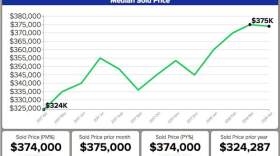For years after the recession, there were zero new homes built in Fernley, which was dubbed the foreclosure capital of the US. In 2017, there were more than 200. It's part of a larger trend as people start to look outside of Reno/Sparks for a place they can afford to live. Our reporter Jacob Solis spoke to an official in Fernley to find out more.
Daphne Hooper is the city manager in Fernley. Daphne, many parts of the region like Reno/Sparks struggle to find the space to put more housing, but that's not really the issue for Fernley, right?
We do have room to build home, I think a bigger challenge for us is affordability. You know, the market is going upward and so I think the cost of affordable homes is becoming a challenge. The vacancy rates are low, and so you know, the cost of homes are driving up.
Part of the challenge is that, while there is a great number of jobs coming in, especially in the industrial area, the wages don't necessarily match the kinds of housing that's available, so if you have folks making $15, $16, $17, even $20 an hour, and you do the formula of you have to have two and a half times your wage in order to pay for a home, I think the price points are sometimes out of reach for some folks.
From the city's perspective, when it comes to building those affordable housing units, the high density stuff, how exactly do you do that? How do you do that through policy?
So what we're trying to do now is, we're in the middle of our master plan, updating our master plan to look at those areas that allow for higher density, multi-family attached homes, to be able to identify those areas where those kinds of projects can be built.
What about traffic? Just personally, what have you noticed with traffic trends in the last couple of years?
Traffic is always concerning, particularly between Reno and Fernley with the industrial park there, you're seeing significant increases in traffic and an impact on I-80. In Fernley, we've seen some of that as well.
You know, we only have two exits into Fernley from the freeway, so you have to kind of look at where things are going to be built, and what impact that will have on access and long-term traffic issues.
From your own perspective, not necessarily as city manager but as someone who lives in Fernley, how's it felt to see this kind of growth over the last two years?
It's interesting. You know, when Fernley was incorporated in 2001, we had 7,000 people, and now we're close to 20,000 people. And so you've seen growth, there is an impact on the number of people, the demographics have changed a little bit, and people's needs and wants change.
We're kind of in a transition of old Fernley and new Fernley, and we're trying to figure out what it is that we want to look like. We're taking that into account, and we've spent a lot of time over the last couple of years working on planning components. We just finished a parks master plan, we're working on a water resource plan, we're working on our master plan, so all of those things — we're having those discussions about what it is we want Fernley to look like, how we're going to get there and how we're going to pay for it in the long run.
When you say old Fernley/new Fernley, can you describe that? What's old Fernley for someone who doesn't know?
So Fernley was established as a farming community, primarily agriculture. And we've seen things change over the years, you know a lot of the farms aren't here anymore. We've seen a lot of housing and business come into Fernley, and there's just a transition of what our city looks like. I think those are the discussions that we have with our council, with our staff and with our community.
Those are things that we talk about: what it is we want to look like. For a long time, we've been a bedroom community to the Reno/Sparks area, so how do we work on becoming our own self-sufficient community, and be able to have jobs and services and industry here that will be able to support our community.







